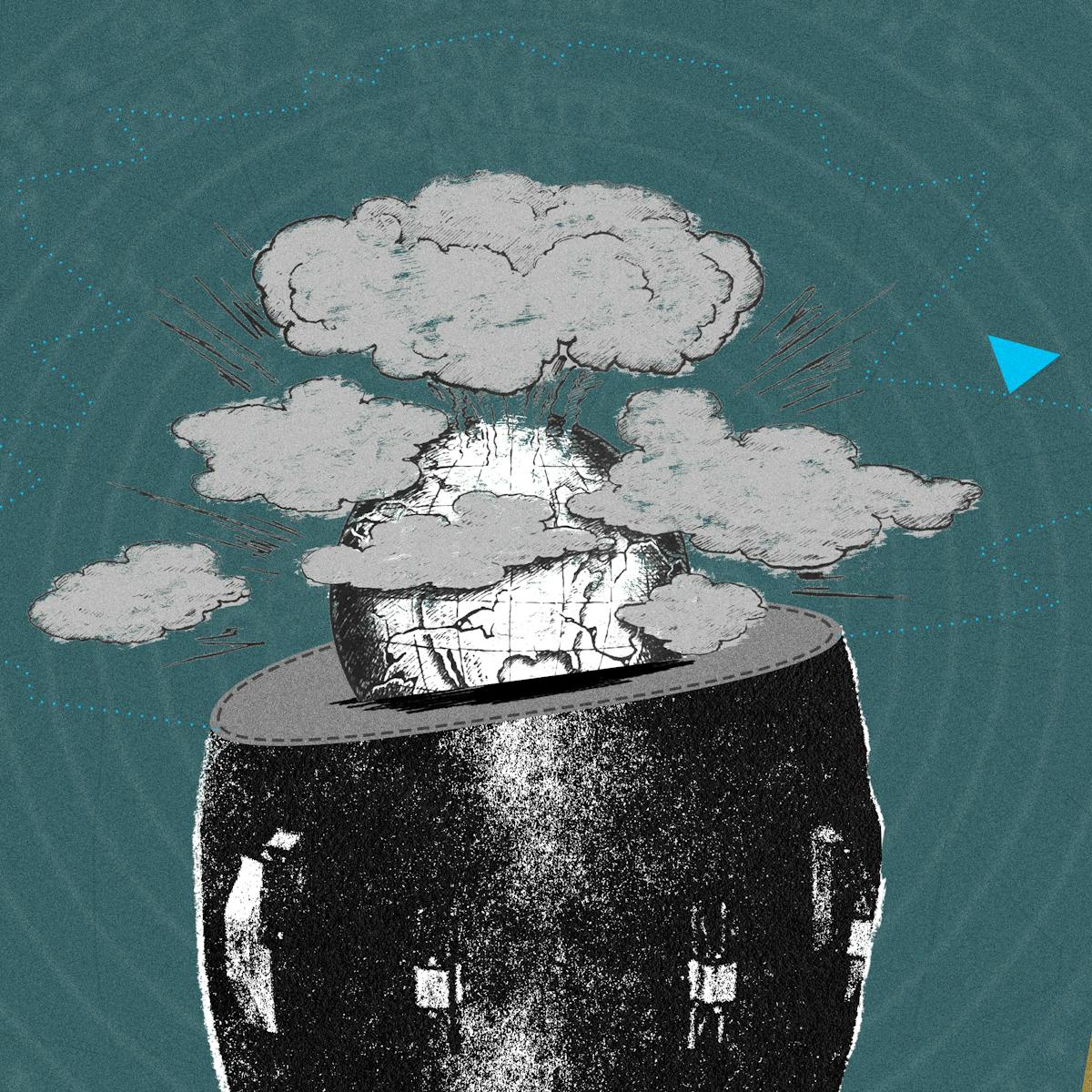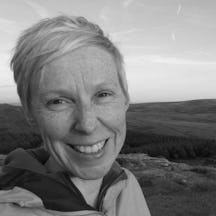The threat to human life from global heating is becoming increasingly obvious. But the spectre of a return to ice-age temperatures, and the effect of that on civilisation – whether it's volcanic or post-nuclear-war dust that blocks the sun’s light – has been the predominant fear since the dawn of modern science.
The big freeze
Words by Charlotte Sleighartwork by Gergo Vargaaverage reading time 6 minutes
- Serial

Emerging from the embers of the Second World War, nuclear weapons threatened to make a third global conflict unsurvivable. Though instant death was a real and imminent danger, there was something about the nuclear winter – caused by clouds of dust blocking the sun – that was almost more alarming. It spoke of the reversal of geological time, the return to an ice age – and with it, the reeling back of civilisation.
For the Europeans who dominated the early decades of modern science, being too cold was a greater source of fear than being too hot. In the years while philosophers at the newly founded Royal Society of London dreamed of new frontiers for science, the Thames regularly froze over in metres-deep ice.
The Little Ice Age
Climate historians today refer to the period encompassing the 16th to the 19th centuries as the Little Ice Age. Glaciers obliterated Alpine villages; crops failed; snow lay piled high for months at a time. Ships lay frozen in at harbour.
The winter of 1783–4 was especially severe. It dragged on and on in the United States, with ice floes reported in the Gulf of Mexico and the Mississippi frozen at New Orleans.
Benjamin Franklin speculated that a “dry fog”, recently observed worldwide, had blocked the sun’s rays and “exceedingly diminished” its capacity to warm the Earth. He thought it likely that its ultimate origin was the “vast quantity of smoke” produced the previous summer by a volcanic eruption in Iceland.
By the 20th century, scientists came to grapple with the possibility that such climatic blips might not merely be temporary.
“Benjamin Franklin speculated that a ‘dry fog’, recently observed worldwide, had blocked the sun’s rays and ‘exceedingly diminished’ its capacity to warm the Earth.”
Glaciers and the gradual thaw
One of the big themes in the histories of geology and climate is the question of timescales of change. For a long time it was believed that cataclysmic events were responsible for transitions between geological eras – massive volcanoes or floods – and that the present was a providential period of stability. But in the early 1830s, the British geologist Charles Lyell persuaded scientists that slow and gradual change was responsible for the landscape we see today.
Just a few short years after Lyell published his findings, a trio of scientists walked the Swiss Alps looking for evidence of the past extent of glaciation. What they saw (and what locals reported) persuaded them that entire epochs of the Earth’s deep past had been dominated by ice and snow. One of them coined the term Eiszeit (ice age) to describe these fearful periods. Another, Louis Agassiz, took the science with him to America, where it eventually found believers.
Agassiz retained his beliefs that God had created humans after the ice, but most scientists were left with the challenge of imagining one or more human species negotiating their survival in a dramatically changing climate.
Cold War and fears of a cold planet
Reconciling the geological truth of Lyell’s “uniformitarianism” with the observable vagaries of jumpy nature has remained a challenge to the scientific imagination. A century after Agassiz, as Americans grappled with the awful potential of nuclear weapons, volcanic explosions featured strongly in their collective imagination. For what was a bomb but a terrifying, man-made volcano?
To put the matter more scientifically, they wondered whether the soot raised by nuclear firestorms would have the impact of Franklin’s example or the more recent and better-studied eruption of Krakatoa (1883), which also seemed to have caused cooler temperatures and record rainfalls.
“As Americans grappled with the awful potential of nuclear weapons, volcanic explosions featured strongly in their collective imagination. For what was a bomb but a terrifying, man-made volcano?”
Meteorology was a key science during the Cold War. In the short term, generals wanted to know what weather conditions their troops and missiles would face. In the longer term, an unstable climate and the famines this would cause might help tip a state into instability or even communism. Game theorist John von Neumann suggested in the 1950s that climate-changing acts of aggression “could become more potent than nuclear war”.
It was in this context that scientists hunted for a euphemism for nuclear war – deemed by NASA to be unnecessarily perturbing to the American public – and came up with “nuclear winter” instead. In their 1983 paper, they projected post-nuclear smoke shrouds lowering land temperatures to minus 15 or minus 25°C, dimming the sunlight needed by crops and producing “a serious threat to human survivors”.
The British government sought to suppress such talk as scaremongering. The ‘Cold’ War seemed suddenly literal: an apocalypse was at hand, and hell turned out to be made not of fire, but of ice.
Climate change and the cold
Historian Matthias Dörries notes that the newly coined phrase “brought climate change and nuclear weapons together… linking pressing Cold War issues to worries over the planet’s environmental future”. The history of climate-change science is very much entwined with Cold War research and imagination.
More recently, discredited climate-change deniers sought plausibility for their proposal that the Little Ice Age was a blip in the data, creating a baseline for temperature change that was too low: a fake Soviet chill that did not apply to the West.
“Scientists projected post-nuclear smoke shrouds lowering land temperatures to minus 15 or minus 25°C, dimming the sunlight needed by crops and producing ‘a serious threat to human survivors’.”
Imagining climate change is difficult because history and geology can appear to be telling conflicting stories. Geological gradualism takes place over vast periods of time, and even a volcanic eruption is insignificant in the long term. Yet human activity, even within living memory, can shape entire epochs.
Nuclear science, in one respect, helped to establish this fact, by revealing the dizzying longevity of radioactive waste, which extends its poisonous effects into the geological future. In another sense, though, it was a mis-steer, reinforcing the fear of cold even as temperatures crept up.
For a Briton, the prospect that London could develop the climate of Barcelona might sound like a pretty appealing outcome. Fossil-fuel and right-wing propagandists claim that the increased agricultural potential of previously cold regions will make climate change, overall, a good thing.
The reality is that heat will make many countries across Africa, South America and the Middle East unliveable. One third of the world’s food-producing land may be at risk, due not to cold, but heat.
Northern-hemisphere ways of imagining temperature – fearing cold more than heat – continue to dominate our thinking about climate change. It’s time to shake off the Cold War Eiszeit and adjust the thermostat of collective imagination.
About the contributors
Charlotte Sleigh
Charlotte Sleigh is an interdisciplinary writer and practitioner in the science humanities. Her most recent book is ‘Human’ (Reaktion, 2020). She is Honorary Professor at the Department of Science and Technology Studies, UCL, and current president of the British Society for the History of Science.
Gergo Varga
Gergo Varga is an illustrator, collage animator, motion designer and the name behind ‘varrgo’. varrgo is a place where Gergo creates and animates mixed-media projects, particularly in the style of collages and cut-outs. He enjoys working with things that have already had a life, from old magazines to scribbles in a notebook. His longest-running creative project is ‘oners’, where he visualises one-minute quotes from contemporary thinkers. Gergo created the animations and illustrations for ‘Apocalypse How?’ and ‘Eugenics and Other Stories’, published on Wellcome Collection Stories.

